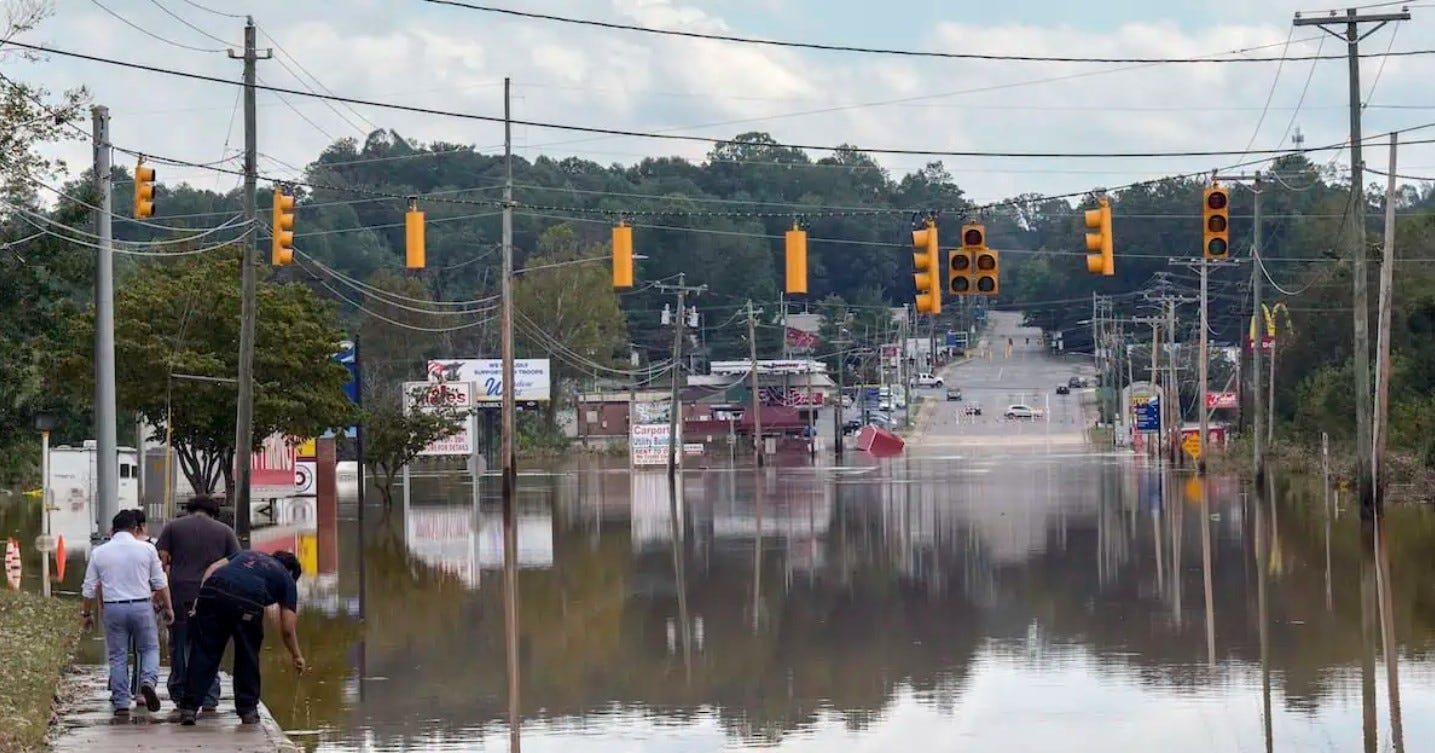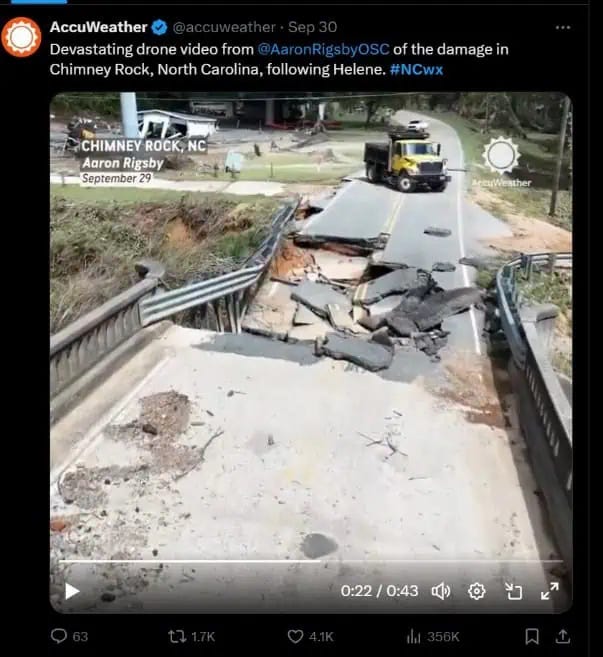Towns are gone. Others devastated. The aftermath of Hurricane Helene in the Southern Heartland
May God bless and comfort our fellow Americans in their hour of desperation and need.
Hurricane Helene churned up the Gulf, veered right, and slammed into the coastline of Florida in the crook of the state where the Florida Panhandle wraps around the Gulf. Forecasters, both official and freelance, predicted the worst for Florida, with storm surges of up to 20 feet. Florida knows how to handle hurricanes, and while damage has been devastating in places, there was little loss of life.
After hitting land, Helene crawled up Florida and swung left, creeping up along the spine of the Appalachian Mountains, dropping torrential rains into the lakes, reservoirs, rivers, and streams of the Tennessee Valley and nearby regions. The mountain communities in North Carolina and Tennessee were already isolated from each other, often with only one or two roads connecting them to the outside world. These little towns were hit the worst, with whole communities being literally wiped from the map. At least 160 people have died as a result of the storm, with more than 40 dead in Buncombe County alone, the seat of badly hit Asheville, North Carolina, a well-known mountain vacation destination.
The geography of the area is steep; mountains and valleys with narrow roads and bridges connecting the tiny communities to the larger world. So much rain came that some dams were over-topping, threatening the structures. Earth became so waterlogged that mudslides broke free from the mountains, flashing through some of the communities. Raging water from rivers and streams pushed whole trees, trucks, cars, semi-trailers, and the debris from destroyed homes downstream. Debris that wasn’t moved along has piled up into debris mountains, blocking roads, train tracks, and filling waterways. All that debris and the forces of water have undermined and torn up roads, demolished bridges, and damaged water management systems. The Tennessee Valley Authority reports that they have 49 dams to manage the lakes and rivers and the reservoir system. That is a lot of infrastructure to inspect, protect, and restore.
Because towns are cut off, there has not even been a full rescue and recovery, let alone an inventory of the dead and missing, as well as property damage. One video, “Everything’s Gone,” shows a towering wave of mud rushing down a hill and sweeping past the person filming as it pours down the mountainside. “My car is gone…” “I’m OK, it’s OK.”
I saw a short video on X by a real estate agent with 30 years in the business who is collecting supplies and delivering them to nearby affected communities. Leigh Brown indicated that in addition to the flooding, debris, and devastation, there is now widespread looting. She said she was advised by a sheriff’s deputy that anyone coming into the region to assist needed to be armed and “safety off.” She is helping to organize donations for nearby communities. “You are not forgotten by the rest of North Carolina,” she said, and “this ain’t about your granite countertops,” you’all, it is about the culture and the generational homes of this region. “Chimney Rock is gone, Swannanoa, gone, Montreat, gone. Other towns, damaged beyond repair.”
Remnants of communities are stranded without water, communications, fuel, food, life-preserving medicines, first aid, and rescue from being trapped. Animals sensed the coming deluge, with bears taking refuge high up in trees prior to the worst of the flooding.
The Mountain Mule Packer Ranch assembled its animals and embarked with pack mule strings, heading to the first town on its list that had had no contact since the storm. The Mountain Mule Packers have over 30 years of “extreme terrain logistics and are packing vital supplies into remote, inaccessible areas hit hard.”
Asheville was receiving 97,200 lbs of food, 516 personnel moved, and 60 hoist rescues via helicopters from the North Carolina National Guard.
There were complications: a private citizen and former law enforcement officer (LEO) owns a private helicopter in the region and started flying rescue missions with his co-pilot son into the Lake Lure area that had been flooded and cut off from the outside world. They rescued half a dozen people before being ordered by the Lake Lure fire chief to stop rescue efforts. The pilot was told he would be arrested if he did not stop. Forced to leave, he could see others on the ground seeking rescue as he flew out of the area.
He was not the only helicopter in the region by any means. A video loop of 14 hours of helicopter traffic was posted on X (formerly Twitter), with the poster noting most of the helicopters are civilian.
Rescue crews are assembling throughout the region and the East Coast. Missouri Task Force 1 assembled 65 members, “working rescue missions in Florida, North Carolina, Georgia, and South Carolina.
On September 28th, more than 700 military from the Tennessee Army National Guard’s Armored Cavalry Regiment departed for a year-long deployment in the Middle East. Libs of TikTok reported on Sept 30th that the 82nd Airborne Division, known as America’s Global Response Force with thousands of paratroopers. “They provide combat capability, but also helicopter airlift, stand-up hospitals, and other support.” They are stationed in North Carolina, and although they were called up to assist in Hurricane Katrina in New Orleans, they have not yet been called up to assist.
President Biden was asked why he wasn’t back in the White House over the weekend instead of in Deleware when the storm hit, and he snapped, “It’s called a telephone,” declaring he had been on the phone for two hours. When he was asked on Sunday if there was any more aid coming to the devastated regions over the weekend, Biden said that enough aid had already been given to the impacted areas. The New York Post reported that at two later events, Biden attempted to walk back that comment.
Meanwhile, President Trump started a GoFundMe page for victims of Hurricane Helene and has raised more than $3.8 million as of October 2nd.
Meanwhile, Florida Governor DeSantis is sending assistance and aid to Florida’s sister states devastated by Hurricane Helene, including, to begin with, “10 trucks of water, more than 100 Starlink satellites to help with internet connectivity, three airboats, an aircraft and search-and-rescue teams. He’s also sending infrastructure assessment teams, temporary bridge materials, project and contract management teams with the Florida Department of Transportation.”
Election Day is less than six weeks away, and there is grave concern about these communities’ ability to conduct elections. Elections involve paper ballots, working postal services, designated voting centers, Election volunteers, election monitors, and, most importantly, citizens present and able to get to the polls.
There are new storms gathering in the Caribbean on the same general track as Helene took.
Those states are going to need so much help to even begin to reestablish a semblance of normal. Other events may complicate rebuilding efforts. The President of the International Longshoremen’s Association (ILA) gave a blustering interview designed (no doubt) to scare the bargainers into caving in and just agreeing to the labor union’s new terms. He described in excruciating detail the kinds and numbers of materials that were not going to be available with every major port on the East and Gulf Coasts closed down. Midnight of September 30th was the deadline to strike and now it has begun.
General Mike Flynn declared on X about the strike: If you didn’t know what the art of the deal was, this is it. Get ready America, maybe this is the black swan no one anticipated. I certainly didn’t, not at this moment. And anyone who believes Biden or Harris can handle this or anyone else in their administration, needs to think twice.” We would add, we don’t think anyone would dare talk the way the ILA president did if Trump were in office.
UPDATE: The videos and stories keep pouring in, cataloging the dire circumstances of our citizens in the South. Florida lost 11 souls to Helene and suffered massive property damage.
The mountain communities in Tennessee, North Carolina, South Carolina, and Georgia are beyond devastated. The dead are not yet recovered, and the smell of death hangs in the air. There are continuing reports of volunteers being prevented from helping their surrounding neighbors, in an echo of what happened during the Maui catastrophe.
Too often domestic animals and pets were left behind. Animal rescue teams were out working to collect the dogs, cats and other creatures left behind. A wedding party that was at their event venue over the weekend were told by the owners to just leave the animals on the farm. Instead they rescued three horses and goats locked in a shed, only losing JJ the donkey during the effort.
Truckers trying to bring supplies and rescue gear into Tennessee report that over 50 semi-trailer trucks had their tires slashed in a senseless act of terrorism. FEMA has been absent from many of the most damaged areas, according to local reports on X. One video states that there are text messages from Tennessee/FEMA telling citizens not to help their neighbors and to donate to FEMA, not directly to individuals.
May God bless and comfort our fellow Americans in their hour of desperation and need.
On Tuesday, President Trump and his wife were on the ground in Hendersonville, meeting with some of the survivors.
By the way, Trump’s GoFundMe page for the Helene victims has gone up again to 3.8 million dollars.
Primary author: Ginger Breggin
Image: Licensed via AP






It's a time for real leaders to step forward to pledge and provide actual support for those who have been devastated. Why is the Tennessee National Guard going overseas? Why are billions upon billions going to Ukraine, and illegal entrants, while Americans are suffering? Where are Biden and Harris when the country is in need?
Thank you for getting the TRUTH out the us about how these wonderful people are being treated by the very government that is support to assist them isn’t going a thing.